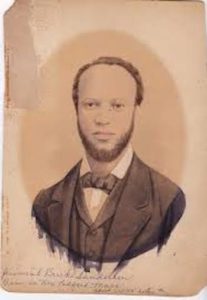
Jeremiah Sanderson
*Jeremiah Sanderson was born on this date in 1821. He was a Black abolitionist and advocate for the educational rights of Black children.
Jeremiah Burke Sanderson was born to Daniel Sanderson and Sarah Burke in New Bedford, Massachusetts. His mother was part of the Wampanoag, and his father was African and Scottish. Daniel Sanderson left the family when Jeremiah was nine years old. Young Sanderson received a good education. The environment in which Sanderson grew up enabled him to watch Blacks vote and attended public schools.
Sanderson worked weekdays as a barber and would preach at the pulpit of local New Bedford religious societies, despite not being an ordained minister then. He was elected secretary of the New Bedford Colored Citizens at nineteen years of age. In 1840 he met William C. Nell and Frederick Douglass in Boston, Massachusetts. Sanderson continued to work with them throughout his life. Throughout the 1840s, he traveled to various cities in Massachusetts and New York, lecturing about the evils of slavery.
In 1841 Sanderson gave a speech at the Massachusetts Anti-Slavery Society meeting that impressed many other well-known abolitionists, including Parker Pillsbury and Edward Quincy. In 1853 Sanderson was appointed as a delegate for the National Convention of Colored People, and in 1854 became a member of the State Council of Colored People of Massachusetts. On February 4, 1849, Sanderson married Catherine Molyneaux in New Bedford, Massachusetts. He and his wife had a large family, and in 1854, Sanderson moved to California temporarily, leaving his family; they would eventually be united in California before 1860.
In San Francisco, Sanderson began to speak at anti-slavery events. This would begin Sanderson's efforts in the West to advocate for black rights and education. In the coming decades, he obtained public funding for Black schools, spoke in churches, and encouraged equal rights for Blacks. In Sacramento, he noticed that a community with over two-hundred school-age Black children had no public school, only one private school for Black children in the basement of a house. Sanderson and the school board agreed to fund a Black school, which opened in 1855, where he taught. Sanderson tested to get a teaching certificate and became one of the few Black teachers in the state.
He was also appointed secretary for the first convention of the Colored Citizens of the State of California. In 1859, Sanderson returned to San Francisco to teach at a black public school in the basement of a church. As a response, Sanderson sent letters to parents of Black children urging them to take advantage of the public school system. He once again reached out to the school board and secured funding to construct a new building that would allow his school to move out of the church. This new school, named the Broadway School, opened in 1864, and five years later, Sanderson was promoted to principal of the school. However, his Black assistant quit, and a white woman was hired as a replacement. It was seen as unacceptable for a white woman to work under a Black man, and he was forced to step down to the teacher position.
Sanderson relocated to Stockton, California, where he continued to strengthen the educational system for Black children through teaching. His excellence as a teacher resulted in certain black families sending their children to Sanderson's school from great distances. Sanderson spent his last days in Oakland, California, where his priorities shifted to religion. His daughter Mary Sanderson Grasses would later become the first black public school teacher in Oakland, California. While living in Oakland, he became the secretary of the 1875 annual conference of the African Methodist Churches of California. Sanderson was killed on August 19, 1875, when he was struck by a Southern Pacific train. He died instantly in the accident.
To Become a School Principal
To Become an Elementary School Teacher